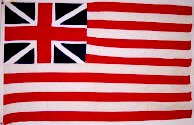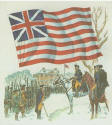 Grand
Union Flag
Grand
Union FlagAlso known as the First Navy Ensign and the Cambridge Flag.
 Grand
Union Flag
Grand
Union Flag
Also known as the First Navy Ensign
and the Cambridge Flag.
Date: January 1, 1776
Thirteen alternating red and white stripes (seven red and 6 white). Same canton as the British Red Ensign. (R10)
The relatively small size of the American naval forces resulted in the use of only a small number of naval flags. The Grand Union was one of these.
On land, however, the existence of many groups of local militia had the opposite effect. A great variety of banners were carried by the various military units.
Washington had seen all the various flags proudly flying in defiance of England as he reviewed his soldiers at Cambridge in July of 1775. It was very confusing. If he chose one of the local flags, it might arouse envy among the various groups and rivalry may have destroyed the unity necessary to prosecute a war.
It is not known to whom General Washington spoke about the necessity of a common banner, or who designed it or where it was made. There are conflicting stories about the origin of the flag. One such story is told at the Star Spangled Banner House in Baltimore.
Colonel Benjamin Flower served on Washington's staff as Commissary General. Col. Flowers sister was Rebecca Flower Young. While in Philadelphia, where the Young's lived, Washington called on Mrs. Young, a professional flag maker, and asked her to make the army a flag. Mrs. Rebecca Young later moved from Philadelphia to live with her daughter in Baltimore. This daughter, Mary Young Pickersgill made the thirty by forty-two foot, 15 stars and striped flag which flew over Fort McHenry on September 13th and 14th, 1814.
 On
January 1, 1776, Gen. Washington reviewed the Continental Army of
Prospect hill in Cambridge, Massachusetts, and the Continental Flag, or
Grand Union Flag was raised on the the flagpole. The Grand Union was not
an official flag for it had never been authorized by the Continental
Congress. It served the United Colonies from January of 1776 until the
adoption of the first version of the Stars and Stripes on June 14, 1977.
On
January 1, 1776, Gen. Washington reviewed the Continental Army of
Prospect hill in Cambridge, Massachusetts, and the Continental Flag, or
Grand Union Flag was raised on the the flagpole. The Grand Union was not
an official flag for it had never been authorized by the Continental
Congress. It served the United Colonies from January of 1776 until the
adoption of the first version of the Stars and Stripes on June 14, 1977.
Because it was not an commission flag, it was not normally carried by the Revolutionary troops in the field. Groups carried their own state or regimental colors and standards.